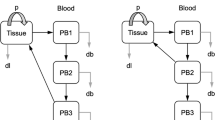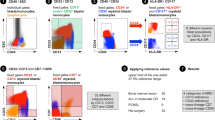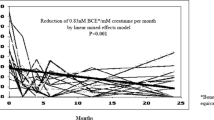Abstract
During a 15-month period, we used in vivo bromodeoxyuridine (BUDR) infusion to study cell kinetics in 112 consecutive patients with various types of malignant tumours: acute leukaemia (50 patients), gastric cancer (42) and brain gliomas (20). The in vivo BUDR method requires that a single tumour sample be taken 4-6 h after infusion and that bivariate flow cytometry (FCM) be employed to measure simultaneously the percentage of BUDR-labelled cells (which are identified with a green fluorescent anti-BUDR monoclonal antibody) and their mean DNA content (following propidium iodide staining). This technique rapidly furnishes the labelling index (LI) and the DNA synthesis time (TS), from which the tumour potential doubling time (Tpot) and production rate (fractional turnover rate, FTR) are calculated. The procedure took 6-9 h to complete and there was no immediate toxicity from BUDR administration. Successful LI and TS determinations were obtained in 89 (80%) and 80 (72%) of the 112 patients, respectively. Correlations were sought between kinetic parameters and a number of pathological and clinical ones. In 34 patients with acute non-lymphoblastic leukaemias who were uniformly treated for remission (CR) induction and maintenance, proliferative activity, as measured by Tpot and FTR, was greater in responsive than in non-responsive patients, and in those who experienced CR for over 8 months than in those who had a shorter CR. Proliferative activity was also greater in patients with advanced gastric cancers than in those with more limited disease. No correlations between kinetic and clinical and pathological parameters were found in gliomas. These data indicate the in vivo BUDR infusion coupled with FCM measurements can be performed in clinical settings to obtain kinetic data rapidly in quite large patient series. This will probably allow the inclusion of kinetic data in clinical trials aimed at evaluating the prognostic relevance of these data.
This is a preview of subscription content, access via your institution
Access options
Subscribe to this journal
Receive 24 print issues and online access
$259.00 per year
only $10.79 per issue
Buy this article
- Purchase on Springer Link
- Instant access to full article PDF
Prices may be subject to local taxes which are calculated during checkout
Similar content being viewed by others
Author information
Authors and Affiliations
Rights and permissions
About this article
Cite this article
Riccardi, A., Danova, M., Dionigi, P. et al. Cell kinetics in leukaemia and solid tumours studied with in vivo bromodeoxyuridine and flow cytometry. Br J Cancer 59, 898–903 (1989). https://doi.org/10.1038/bjc.1989.190
Issue Date:
DOI: https://doi.org/10.1038/bjc.1989.190
This article is cited by
-
Bromodeoxyuridine: a diagnostic tool in biology and medicine, Part II: Oncology, chemotherapy and carcinogenesis
The Histochemical Journal (1995)
-
Bromodeoxyuridine: a diagnostic tool in biology and medicine, Part I: Historical perspectives, histochemical methods and cell kinetics
The Histochemical Journal (1995)
-
Activation markers and cell proliferation as indicators of toxicity: A flow cytometric approach
Cell Biology and Toxicology (1995)
-
Cell proliferation in human tumours growing in nude mice: renal cell carcinomas, larynx and hypopharynx carcinomas
Journal of Cancer Research and Clinical Oncology (1992)



